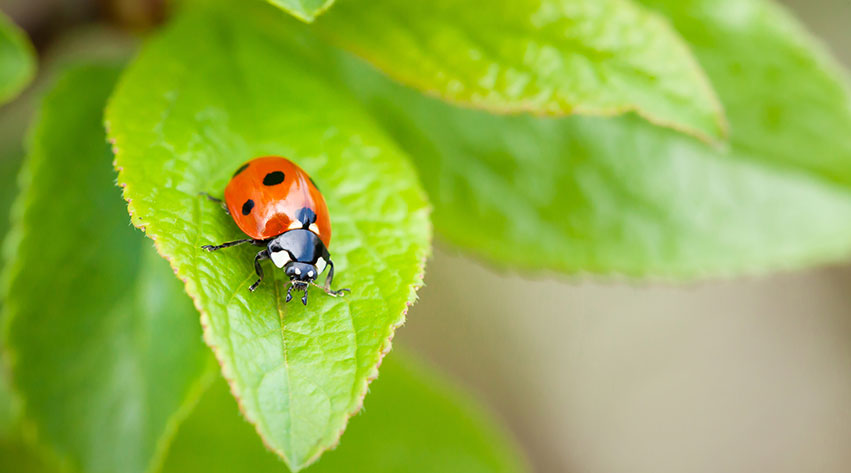
How to attract insects to your garden
Most insects hibernate through the winter months and encouraging them to do so in your own garden will be beneficial for the following year. Many, such as ladybirds, will begin breeding in the spring and both they and their larvae eat huge numbers of aphids. Wasps and lacewings are among other insects whose larvae devour large numbers of garden pests.
First things first…
If you want to make your garden a regular visiting spot for insects, it’s incredibly important to avoid using pesticides if you can and be sure to never spray open flowers. Try to rely on organic methods of pest control such as using good cultivation, garden hygiene and other biological controls wherever you can.
Attracting ladybirds
Ladybirds are a bright and colourful addition to any garden. As well as their aesthetic appeal, they’re also incredibly useful - they eat aphids, making them a worthy garden protector. To attract Ladybirds to your garden, try:
- Planting the right things. Ladybirds love to eat Angelica, Calendula, Caraway, Chives, Cosmos, Dill, Fennel, Feverfew, Marigold Statice, Sweet Alyssum and Yarrow to name just a few!
- Make sure they’ve got food, water and shelter. If they’ve got flat rocks under which to shelter, bugs to eat and water to drink, they’re more likely to stick around.
If you’re not finding these visitors arrive readily, you can buy ladybirds to add to your garden, but once you’ve got them, you’ll have to do a bit of legwork to make them feel welcome. As well as the above, if you buy ladybirds, try:
- Releasing them at the right time. Twilight hours are the best time to release the ladybirds, they’re less likely to fly off at this time.
- Putting them in the right place. As you might have guessed, the best place to release the ladybirds is right next to the food and water sources: if you do that, they’re immediately going to learn that your garden is a good place to be.
Attracting bees
Bees and other pollinating insects are also a great addition to every garden, and are essential for assisting with the crop growth of most fruit and vegetables. If you’re keen to attract bees to your garden (and we recommend that you are), try these tips:
- Nectar and pollen rich plants are crucial for supporting pollinators; Foxgloves, Honeysuckle, Wild Marjoram, Roses, Common Jasmine, Bergamot and English Lavender are all plants which will help draw bees and pollinators to your garden.
- Provide nest sites for bees; either make your own or you can purchase nests for solitary bees. Some solitary bees nest in the ground, either in bare soil or short turf. They will find their own nest sites, so tolerate the small mounds of soil deposited by the female bees when they excavate their nest tunnels.
- Make sure all the pollinators that come to your garden have access to water as they sometimes need a drink. A shallow dish filled with stones or water is a good and safe source of water for these garden visitors.
Attracting butterflies
Butterflies are a beautiful and interesting addition to gardens who will visit to feed on nectar from a range of flowers. A few species have caterpillars that are garden pests, but most won’t cause any damage to your garden. There are 59 species of butterfly in Britain - the most common of which include Red Admiral, Peacock, Brimstone, Painted Lady, Comma, Green-veined White, Small Tortoiseshell, Small Cabbage White and Large Cabbage White. So how do you tempt these pretty creatures to visit your garden?
- Butterflies can be encouraged to visit gardens by growing a range of suitable flowers from March until the butterfly season ends with the arrival of frosty weather in October or November. Many of the plants that attract bees (listed above) will attract butterflies too as they’re another pollinator.
- If you’re keen to attract a specific breed of butterfly, you can tailor your plant growth accordingly. Alder Buckthorn and Purging Buckthorn will attract Brimstone butterfly while Bird’s-foot Trefoil will tempt the Common Blue. True to their name Cabbage White butterflies (both large and small) will be drawn to Cabbage, other brassicas and Nasturtiums. Currants, Elm, Hop and Willows will bring in Comma’s and Docks and Sorrels will appeal to Small Copper butterflies.
- Leave fallen fruit under fruit trees. In late summer, butterflies such as Red Admiral and Painted Lady will feed on fruit juices in fallen over-ripe pears, plums and apples.
Bug hotels
As well as ‘bug boxes’ or ‘bug hotels’ that are available to buy from your local Garden Centre which you hang in a suitable positions in trees or on fences, you may like to build your own. This is a great project for children to help with.
- Cut the bottom off a plastic drinks bottle and put in a roll of corrugated cardboard inside.
- Thread some fine wire through the plastic to hold the cardboard in place.
- Leave the lid on the bottle to stop the rain getting in, making the cardboard soggy!
- Hang up in dense foliage in trees and shrubs in mid-August so that the insects can begin moving in.
- Dry, hollow plant stems or hollow bamboos, cut to length, can be bundled up and used instead of rolls of corrugated cardboard. They will still need to be secured with fine wire to stop them falling out.
- For a larger abode, metal catering sized coffee tins are ideal!
Choosing a site for your bug hotel
- Hang your bug hotel in a tree or on a fence. Make sure that the entrance faces away from prevailing winds so that the rain does not get driven in. Insects need a dry home for the winter.
- Hollow stems left on plants through the winter provide a natural home for insects and other bugs.
- Leaving leaf litter on the borders through winter will also support many insects as will log and stone piles.


